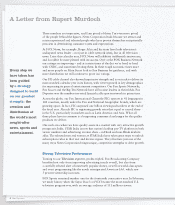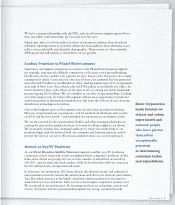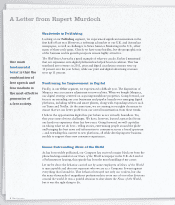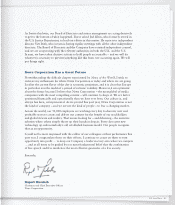Twenty-First Century Fox 2011 Annual Report Download - page 14
Download and view the complete annual report
Please find page 14 of the 2011 Twenty-First Century Fox annual report below. You can navigate through the pages in the report by either clicking on the pages listed below, or by using the keyword search tool below to find specific information within the annual report.
Management’s Discussion and Analysis of Financial Condition and Results of Operations (continued)
Television and Cable Network Programming
The Company’s television operations primarily consist of FOX, MyNetworkTV and the 27 television stations owned by the Company.
The television operations derive revenues primarily from the sale of advertising and to a lesser extent retransmission compensation. Adverse
changes in general market conditions for advertising may affect revenues. The U.S. television broadcast environment is highly competitive and the
primary methods of competition are the development and acquisition of popular programming. Program success is measured by ratings, which are
an indication of market acceptance, with the top rated programs commanding the highest advertising prices. FOX is a broadcast network and
MyNetworkTV is a programming distribution service, airing original and off-network programming. FOX and MyNetworkTV compete with
broadcast networks, such as ABC, CBS, NBC and The CW, independent television stations, cable and DBS program services, as well as other
media, including DVDs, Blu-rays, video games, print and the Internet for audiences, programming and, in the case of FOX, advertising revenues.
In addition, FOX and MyNetworkTV compete with the other broadcast networks and other programming distribution services to secure
affiliations with independently owned television stations in markets across the country.
Retransmission consent rules provide a mechanism for the television stations owned by the Company to seek and obtain payment from multi-
channel video programming distributors who carry broadcasters’ signals. Retransmission compensation consists of per subscriber-based
compensatory fees paid to the Company from cable and satellite distribution systems as well as a portion of the retransmission revenue the
affiliates generate for their retransmission of FOX and MyNetworkTV.
The television stations owned by the Company compete for programming, audiences and advertising revenues with other television stations
and cable networks in their respective coverage areas and, in some cases, with respect to programming, with other station groups, and in the case
of advertising revenues, with other local and national media. The competitive position of the television stations owned by the Company is largely
influenced by the quality and strength of FOX and MyNetworkTV programming, and, in particular, the prime-time viewership of the respective
network.
The Company’s U.S. cable network operations primarily consist of the Fox News Channel (“FOX News”), the FX Network (“FX”), Regional
Sports Networks (“RSNs”), the National Geographic Channels, SPEED and the Big Ten Network. The Company’s international cable networks
consist of the Fox International Channels (“FIC”) and STAR. FIC produces and distributes entertainment, factual, sports, and movie channels
through television channels in Europe, Africa, Asia and Latin America using several brands, including Fox, Fox Crime, Fox Life and National
Geographic Channel. STAR’s owned and affiliated channels are distributed in the following countries and regions: India; Greater China;
Indonesia; the rest of South East Asia; Pakistan; the Middle East and Africa; the United Kingdom and Europe; and North America.
Generally, the Company’s cable networks, which target various demographics, derive a majority of their revenues from monthly affiliate fees
received from cable television systems and direct broadcast satellite operators based on the number of their subscribers. Affiliate fee revenues are
net of the amortization of cable distribution investments (capitalized fees paid to a cable operator or direct broadcast satellite operator to facilitate
the launch of a cable network). The Company defers the cable distribution investments and amortizes the amounts on a straight-line basis over the
contract period. Cable television and direct broadcast satellite are currently the predominant means of distribution of the Company’s program
services in the United States. Internationally, distribution technology varies region by region.
The Company’s cable networks compete for carriage on cable television systems, direct broadcast satellite systems and other distribution
systems with other program services. A primary focus of competition is for distribution of the Company’s cable network channels that are not
already distributed by particular cable television or direct broadcast satellite systems. For such program services, distributors make decisions on the
use of bandwidth based on various considerations, including amounts paid by programmers for launches, subscription fees payable by distributors
and appeal to the distributors’ subscribers.
The most significant operating expenses of the Television segment and the Cable Network Programming segment are the acquisition and
production expenses related to programming and the expenses related to operating the technical facilities of the broadcaster or cable network.
Other expenses include promotional expenses related to improving the market visibility and awareness of the broadcaster or cable network and its
programming. Additional expenses include sales commissions paid to the in-house advertising sales force, as well as salaries, employee benefits,
rent and other routine overhead expenses.
The Company has several multi-year sports rights agreements, including contracts with the National Football League (“NFL”) through fiscal
2014, contracts with the National Association of Stock Car Auto Racing (“NASCAR”) for certain races and exclusive rights for certain ancillary
content through calendar year 2014 and a contract with Major League Baseball (“MLB”) through calendar year 2013. These contracts provide the
Company with the broadcast rights to certain U.S. national sporting events during their respective terms. The costs of these sports contracts are
charged to expense based on the ratio of each period’s operating profit to estimated total operating profit for the remaining term of the contract.
The profitability of these long-term U.S. national sports contracts is based on the Company’s best estimates at June 30, 2011 of attributable
revenues and costs; such estimates may change in the future and such changes may be significant. Should revenues decline from estimates applied
at June 30, 2011, additional amortization of rights may be recorded. Should revenues improve as compared to estimated revenues, the Company
may have an improved operating profit related to the contract, which may be recognized over the remaining contract term.
While the Company seeks to ensure compliance with federal indecency laws and related Federal Communications Commission (“FCC”)
regulations, the definition of “indecency” is subject to interpretation and there can be no assurance that the Company will not broadcast
programming that is ultimately determined by the FCC to violate the prohibition against indecency. Such programming could subject the
Company to regulatory review or investigation, fines, adverse publicity or other sanctions, including the loss of station licenses.
Filmed Entertainment
The Filmed Entertainment segment derives revenue from the production and distribution of feature motion pictures and television series. In
general, motion pictures produced or acquired for distribution by the Company are exhibited in U.S. and foreign theaters, followed by home
12 News Corporation
























